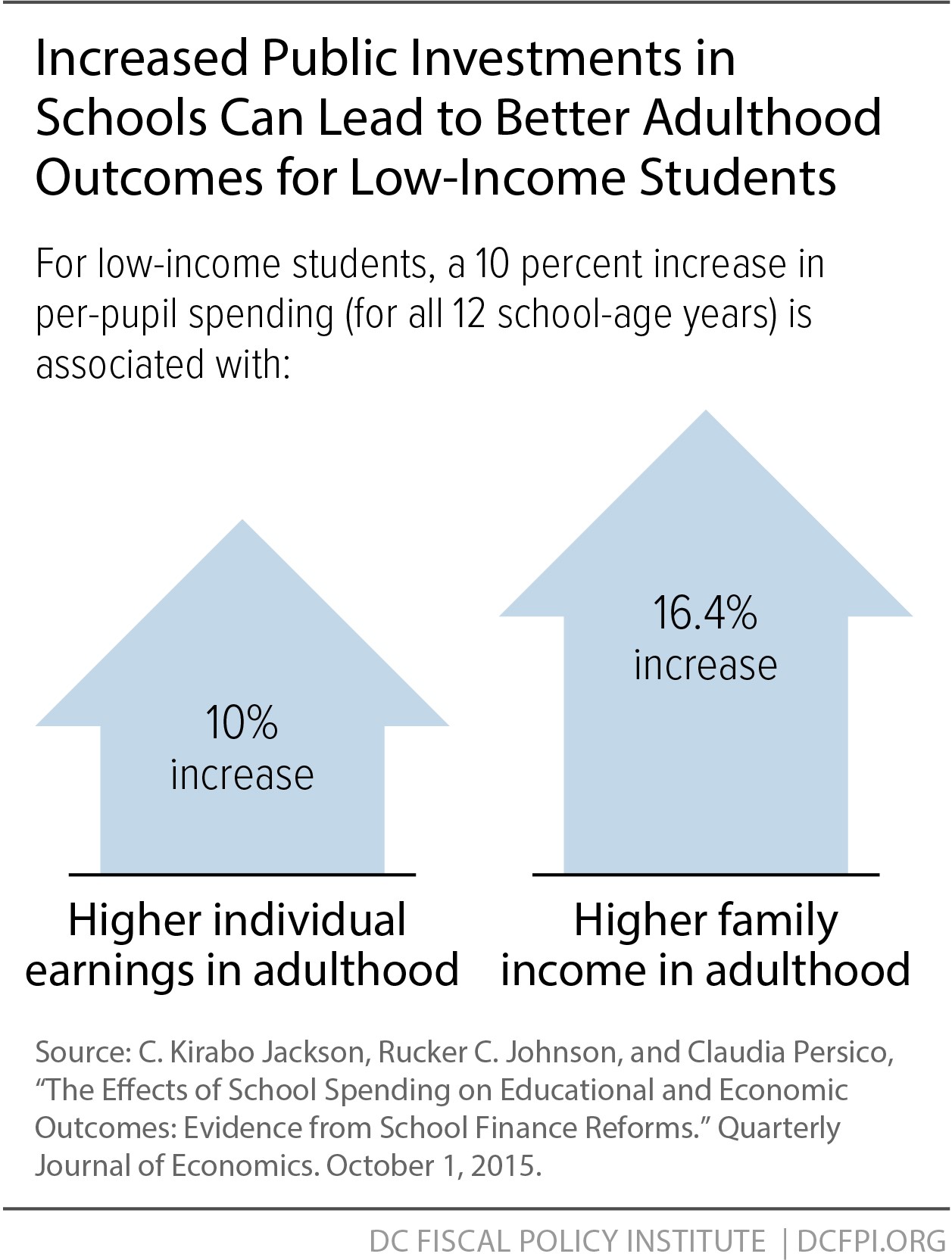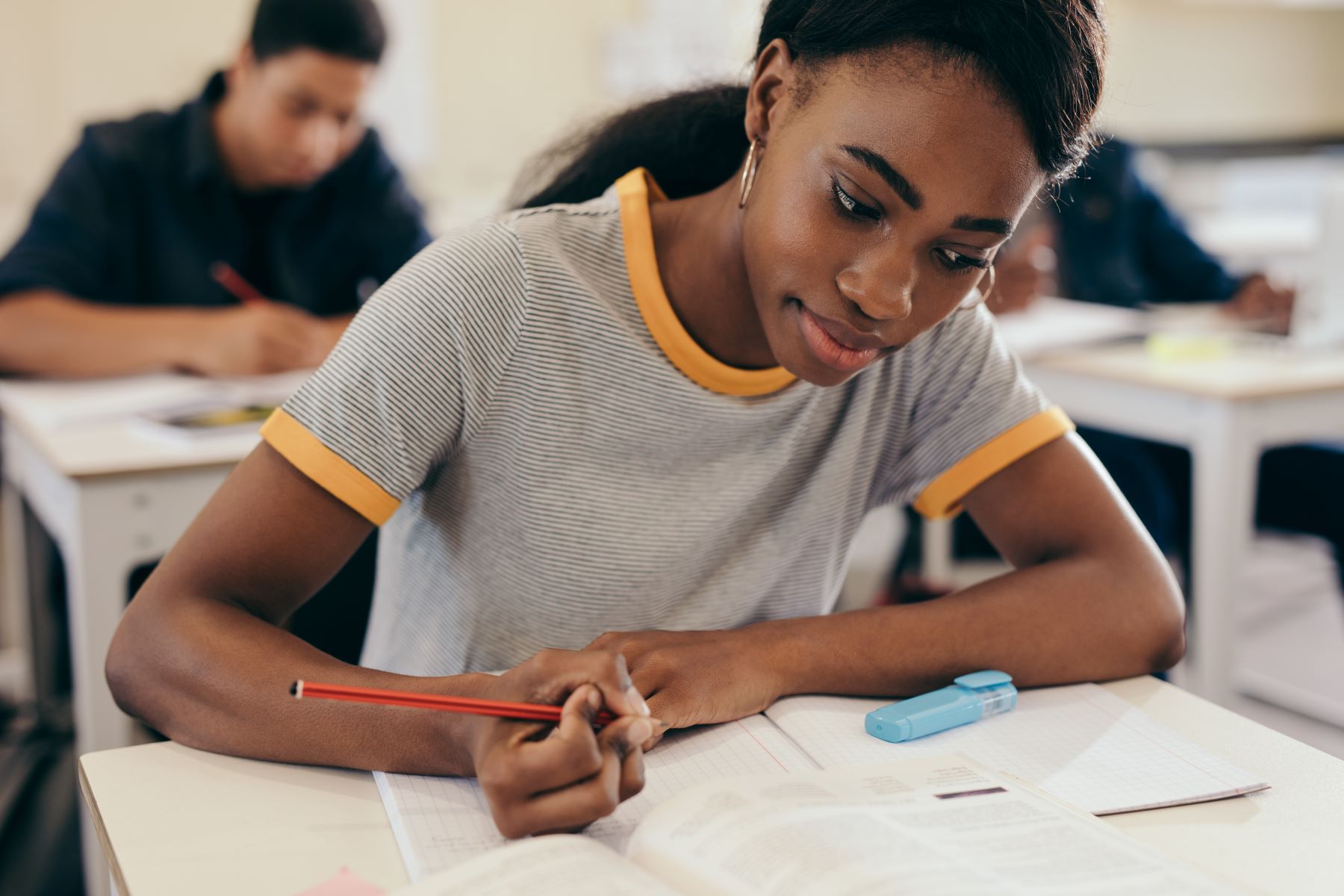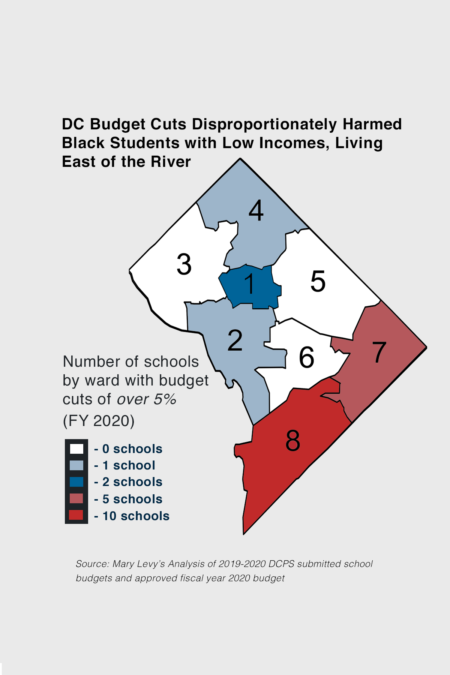In recent years, new evidence on the relationship between public education investments and student achievement makes it clear that money does matter in education—that is, when policymakers invest public dollars wisely and consistently, students tend to achieve better academic and lifetime outcomes. The research shows that targeted education investments are especially important to supporting school success of low-income students and students of color.
These findings have important implications for DC, where policymakers have never funded the education budget at the level recommended by school finance experts. And recently, DC leaders enacted changes to school budgeting practices that have obscured the level of funding needed to keep up with growing educational expenses.[1] These issues are contributing to too few dollars allotted for basic funding per student and to the supplement intended to assist students at risk of academic failure.

To help offset inadequate school budgets, DC Public Schools (DCPS) routinely misuses “at-risk” funds to cover basic staffing positions that the base amount in the Uniform Per Student Funding Formula (UPSFF) is supposed to cover.[2] This practice is disproportionately harming neighborhood schools with high concentrations of primarily low-income Black students, many of whom are already experiencing shrinking budgets as a result of declining enrollment.[3]
Specifically, national and state-level studies have found that:
- Additional investments in public education improve student outcomes, with gains more pronounced for low-income students and students of color. Specifically, these investments lead to higher test scores and high school graduation rates and increase the likelihood of a student attending college and completing a degree.
- Additional school spending can lead to higher lifetime earnings and reduced adult poverty rates.
- Funding cuts in many states during the Great Recession led to declines in student outcomes.
- The investments that can matter the most, depending on implementation, include class size reductions, tutoring support, mental health services and support for social-emotional learning (SEL), and efforts to hire and retain experienced and effective teachers, among others.
The District has an obligation to ensure that all students have the resources they need to achieve academic success regardless of the race or socioeconomic class into which they were born. DC’s students face substantial barriers to success, with nearly half of public school students being considered at risk of academic failure due to their family’s income status or some other hardship measure.[4]
Too few low-income students and Black and Latinx students in DC are reaching the level of academic success they are fully capable of achieving. Only 25 percent of Black students and 34 percent of Latinx students in DC met or exceeded expectations for grade-level learning standards, compared to 82 percent of their white classmates, according to Partnership for Assessment of Readiness for College and Careers (PARCC) test scores.[5] Results are even more troublesome for “at-risk” students—only 18 percent of students met or exceed expectations.
Adequate and targeted public investments in education in DC can help expand access to educational resources that can help reduce opportunity gaps. The research findings detailed below highlight the importance of adequately funding DC’s school budget and ensuring that funds intended to promote education equity—particularly at-risk funds—reach the intended students.
Researchers Present Compelling Findings on the Effects of Money on Student Outcomes
Thanks to the availability of larger data sets and advancements in research methods, a set of new studies strengthens the evidence that public investments in education matter for student achievement and long-term flourishing. Researchers, taking advantage of natural experiments resulting from court-mandated and legislative school finance reforms, have shown that increased state investments in schools can lead to a number of positive outcomes—improved test scores, higher graduation rates, increased likelihood of attending college and earning a degree, and higher adult income (Breakout Box 1). Additional public investments in education can matter even more for boosting the outcomes of low-income students and students of color who are at risk of falling behind.

Public Investments Matter for the Many Dimensions of Student Achievement
Several new national studies show that increased public investments can lead to improvements in student outcomes. The gains have proven to be especially strong for low-income students and students of color.
In a 2018 national study, researchers found that the 26 states that implemented court-mandated or legislated finance reforms between 1990 and 2010 increased the amount of aid they sent to school districts, with these states making overall greater investments in low-income districts compared to high-income districts.[9],[10] These additional investments mattered significantly: National Assessment of Educational Progress (NAEP) math and reading test scores went up in low- and high-income districts, but gains were more pronounced for students in low-income districts.
The researchers found that the effect of additional dollars was cumulative—students’ outcomes improved as they experienced more years of higher funding. Ten years following a reform, one-fifth of the pre-reform achievement gap between low- and high-income districts had closed.
In another national study on the evaluation of school finance reforms, researchers similarly found evidence of the cumulative effects of increased spending. A 10 percent increase in per-pupil spending each year for all 12 years of schooling increased a student’s chance of graduating from high school by 9.5 percentage points, according to a 2015 longitudinal study of national educational and economic data on more than 15,000 children.[11] The additional investments provided a larger boost in achievement to low-income students, whose likelihood of graduating from high school increased by 11.6 percentage points.[12]
The effects of increased public investments can extend beyond the classroom. In the same 2015 study, researchers found that a 10 percent increase in per-pupil funding each year for all 12 years of schooling led to students earning adult wages that were 7 percent higher than wages of students in non-reform states. This increase in funding also led to students having adult family incomes that were 9.6 percent higher. Effects were stronger for low-income students—they earned adult incomes that were 10 percent higher and had adult family incomes that were 16.4 percent higher than their low-income peers in non-reform states (Figure 1).[13]

That researchers found cumulative and/or long-term effects of extra dollars on student achievement underscores that investments today pay dividends in the future. Learning is a cumulative process. Each year a student attends school, they build upon the knowledge and skills from prior years. Comparably, education stakeholders can reasonably expect to see the benefits of additional dollars on student outcomes add up over time—the longer students are exposed to a higher quality education, the better their outcomes are likely to be.
State-Level Studies Bolster the Case that Money Matters
Evidence that money matters for student achievement also comes from state-level studies. From California to New York, policymakers have evidence that increasing funding for schools makes a difference, especially for students who may need extra support to achieve their academic goals.
In a 2017 study, researchers found that California students in grades three through eight attending schools in districts that received “concentration grants”—additional funds given to districts in which at least 55 percent of enrolled students were considered “disadvantaged”[14]—scored higher on state math and reading exams than their peers in neighboring districts that were narrowly disqualified from receiving such bumps in per-pupil funding.[15] Researchers observed similar boosts in achievement for high school students enrolled in an Advanced Placement course at schools in grant-eligible districts. Across both domains of achievement, Latinx students experienced the largest gains.
In a separate paper on the effects of school finance reform in California, researchers found that a $1,000, or 10 percent, increase in per-pupil revenue every year in grades nine through 11 led to increases in student math test scores, with low-income students experiencing gains that were more than twice as high as the average student.[16],[17] Researchers also found that the extra $1,000 each year in grades ten through 12 led to higher graduation rates for students across income levels and different racial and ethnic groups.

In another study, researchers found that Texas students attending schools in districts that received a 10 percent increase in per-pupil funding had higher test scores, lower high school dropout rates, and higher college enrollment rates compared to students in schools without the increased funding.[18] Extra money for operational costs (e.g., instructional and support staff) led to similar improvements in student outcomes in Wisconsin, according to a 2019 working paper.[19] In another study, an additional $1,000 in per-pupil spending led to students in New York State experiencing increases in math and reading test scores.[20]
Great Recession Shows that School Budget Cuts Hurt Performance
While additional collective investments in public schools can put students on a stronger path, reduced public spending can harm students’ outcomes and set them back for years to come. During the Great Recession, as revenues plummeted, many states reduced investments in public education. Students in districts most severely affected by the recession experienced the sharpest declines in test scores, a National Bureau of Economic Research working paper found.[21] Declines in test scores were much more pronounced for low-income students and students of color. According to other researchers, declines in student achievement in districts most affected by the recession persisted for more than three years following the recession even when controlling for other factors, highlighting the potential longer-term consequences insufficient funding can have on students.[22]
How Increased School Funding Can Improve Student Success
There are several ways to target additional educational funding to boost student outcomes. This report does not attempt to summarize all of them, but rather provides a summary of key resources and programs that have been well-researched and serve as potential areas of investments.
Small Class Sizes
Smaller class sizes in early grades (K-3) have produced significant, immediate and longer-term effects on the achievement of low-income students and students of color, particularly Black students.
Evidence stems from the Tennessee STAR (Student/Teacher Achievement Ratio) project, a rigorous, large-scale class size reduction policy experiment involving nearly 12,000 public school children. In the STAR study, a reduction in class size from 24 to 15 students[23] led to Black students in small classes experiencing higher test score gains than their Black peers in larger classes at a rate two to three times higher than the white students in smaller classes did over their white peers in larger classes.[24] These gains effectively reduced the achievement gap between Black and white students on every academic test, with some researchers estimating that the Black-white test score gap would fall by 38 percent in grades K-3 if all students were in small classes.[25]
Follow-up studies on the students in the STAR project have shown the lasting positive effects of smaller class sizes. Students assigned to small classes had higher test scores through eighth grade[26] and were more likely to graduate from high school than their peers assigned to larger classes. And, low-income students who were in small classes for four years saw graduation rates similar to or higher than that of their more affluent peers.[27]
Small class sizes are likely to produce long-term benefits for students of color as well. Notably, one study found that if all of the students who were part of the STAR project were assigned to small classes, the gap between Black and white students taking a college-entrance exam (ACT or SAT) would be reduced by an estimated 60 percent.[28]
Tutoring Programs
Research shows that tutoring can boost the achievement of students who are struggling academically, although the research is mixed on positive effects. Small, intensive tutoring programs may be more effective for low-income students and students of color who have historically had their academic needs unmet.

In a randomized control trial study of a math tutoring program in Chicago, researchers found evidence that low-income, Black and Latinx ninth and tenth graders who participated in the tutoring program for one-hour each day learned “about an extra one to two years’ worth of math above and beyond what the control group learned over the course of the academic year.”[29]
Other research in a major urban city points to the positive benefits of small group tutoring programs. A 2011 study of 35 charter schools in New York City showed that high-achieving charter schools were more likely to offer high-dosage tutoring—that is, where six or fewer students were in a tutoring group that met at least four times per week.[30] Students in schools that prioritized high-dosage tutoring saw higher gains in math and reading.
School-Based Mental Health Services
Around the country, school leaders have looked to school-based mental health services as a promising strategy to improve students’ social-emotional behaviors and help reduce barriers in access to health care, with millions of children now accessing these services.[31]
One in five children have a mental health disorder, with many more children having their needs go unmet each year.[32] Low-income children and children of color are more likely to experience barriers in accessing and using vital mental health services.[33] This has significant consequences as low-income children are often exposed to higher levels of trauma and stress—especially during the early years—leading to underdeveloped social-emotional skills that students need to be active participants in their learning process. As a result, low-income students are more likely to face academic challenges and may display more disruptive behaviors, leading to higher suspension or expulsion rates than their more well-off peers.
Research suggests that school-based mental health services—such as seeing a licensed clinical social worker at school—are worth the investment. In a meta-analysis of 47 rigorous school-based mental health programs, researchers found evidence to suggest that programs like this can have positive effects on the social-emotional behavior of students—an important finding given the relationship between healthy social-emotional skills and school readiness and engagement.[34] The researchers note that not all school-based mental health programs are created equally and that there are key implementation factors that likely improve a program’s sustainability and effectiveness, such as buy-in from school leadership and the inclusion of parents, teachers, or peers.
Social-Emotional Learning Programs
Like school-based mental health interventions, SEL programs can have positive effects on students’ emotional and behavioral health. They can help students develop the skills they need to self-regulate and manage their emotions, build strong relationships and empathize with others, and make responsible decisions. A meta-analysis of 317 studies on the effects of SEL programs on students in grades K-8 found that the average student in an intervention class saw gains across several domains, including improved attitude and social behaviors, reduced behavioral problems and emotional distress, and increased academic performance. The average student who participated in an intervention gained 11 to 17 percentile points on standardized state achievement tests compared to a student who did not participate.[35]
The researchers also found that targeted SEL programs can have outsized positive effects on students who display early signs of behavioral or emotional challenges, and that teachers can be more effective at implementing the programs compared to outside facilitators.[36]

Teacher Quality and Retention
Teacher quality is one of the most important in-school factors affecting student outcomes, academic and otherwise. There are several characteristics that policymakers and researchers believe define teacher quality, with some disagreement. However, years of teaching experience, teacher preparation, licensure and certification, and content and pedagogical knowledge are common characteristics identified as having positive effects on teacher quality.[37]
State education agencies typically examine teacher quality through the lens of teacher effectiveness—that is how well the teacher improves students’ test scores.[38] Students taught by effective teachers are more likely to attend college, earn higher incomes as adults, live in wealthier neighborhoods, and save more for retirement, some research shows.[39] Students taught by less effective teachers tend to have worse academic outcomes, particularly when taught by ineffective teachers consecutively.[40]
More experienced teachers (i.e., those with more years of teaching) tend to be more effective in boosting student outcomes than less experienced teachers[41], and as teachers become more experienced, they tend to earn higher salaries.[42] However, research shows that the positive effect on quality with each added year of experience begins to diminish after a teacher gains five years of experience. This means that on average, a teacher with more experience is more effective than a teacher with little to no teaching experience, but experience alone is not enough to increase or even sustain a teacher’s positive effect on student outcomes.

District and school leaders also confront the problem of retaining teachers in the classroom as they become more experienced. 17 percent of beginning public school teachers (i.e., teachers who has never taught before) leave within the five years of teaching[43] with many teachers citing unsatisfactory working conditions—such as insufficient classroom resources and poor school leadership—as the main reason for leaving.[44]
Policymakers looking to improve student outcomes should pursue policies that boost teacher effectiveness, such as high-quality professional development opportunities that promote ongoing refinement of teachers’ skills, and retention policies that keep quality teachers in the classroom. When teachers stay in the classroom, they gain more experience over time and with the right professional development tools, hone their instructional skills. Teachers who stay in the classroom also have more opportunities to establish positive relationships with students, which can positively impact students’ learning experience. Conversely, a revolving door of teachers can disrupt student learning and may have negative effects on school climate.[45]
Restorative Practices
Restorative practices in schools are modeled after restorative justice, a non-punitive criminal justice approach that emphasizes accountability of offenders by requiring them to face the people they harm by their actions.[46] For example, instead of a principal immediately suspending a student who initiates a fight with another student inside a classroom, the teacher—who has received training— would lead the entire class in a “peacemaking circle” where the offending student and victim would be given a chance to discuss the underlying issues that led to the fight; and their peers would be given a chance to discuss how the fight negatively affected them. In this example, the goals of the circle are to restore harm done to the individual student and broader class community, avoid the need to suspend the offending student, and reduce the possibility of future incidents.
Districts or individual schools adopt restorative practices for a number of different reasons—including promoting a positive, cohesive school climate—but many have done so to reduce racial disparities in school discipline.[47] Students of color face higher rates of out-of-school suspension (OSS) and expulsion compared to their white peers nationally, despite the lack of evidence that students of color misbehave at significantly higher rates.[48] Black boys and girls are three and six times more likely to be suspended or expelled, respectively, while Latinx boys and girls are 1.5 and two times likelier, according to the US Department of Education Office of Civil Rights.[49]
Researchers are exploring whether racial disparities in school discipline are associated with racial disparities in student outcomes. One recent study found that districts with higher Black-white student discipline gaps have higher Black-white achievement gaps.[50] This relationship likely exists given the negative consequences that suspension or expulsion can have on a student’s academic experience. Suspensions and expulsions disrupt students’ learning experiences by causing them to lose out on critical instructional time. Youth who miss too much school tend to have lower academic achievement and face higher dropout rates.[51] School discipline policies—like restorative practices—that help keep students in schools instead of pushing them out may thus be useful in disrupting both inequities in school discipline and student outcomes.
While some districts and individual schools have reported positive effects of using restorative practices, many are in the beginning stages of making these policy changes.[52] More rigorous research is needed to identify evidence-based practices, but policymakers should consider funding pilot programs in schools where principals, teachers, students, and parents are interested in adopting restorative practices to improve school culture and climate and boost student achievement.
DC Leaders Are Shortchanging the District’s Students, Especially Those Facing the Largest Opportunity Gaps
DC may be investing in many of the successful approaches highlighted above, but many school leaders are prevented from fully implementing them due to the inadequate funding they receive. Policymakers’ failure to adequately fund the public education budget harms low-income students and Black and brown students the most—many of whom are growing up in families and communities that are grappling with the historical legacy of racist public policies and practices.
Currently, the UPSFF is $10,980, 7 percent below what school finance experts have recommended as the amount needed to fund schools adequately.[53] In fact, District leaders have never increased the UPSFF to the recommended funding level, with the cumulative gap over the past seven fiscal years totaling over $740 million.[54]
School officials are forced to pit one priority against another in order to stretch their budgets when funding is inadequate. DCPS, facing such pressure, routinely diverts its “at-risk” funds to cover core programming and staffing positions, such as art teachers and librarians, instead of giving these funds to schools for their intended purpose. This practice occurs despite laws explicitly requiring DCPS to add to, not replace, school budgets with at-risk funds.[55]

DCPS’ practice of supplanting at-risk funds disproportionately impacts schools with high concentrations of students at risk of falling behind, many of whom are in Wards 7 and 8. The District is also failing to ensure that schools do not experience significant year-to-year budget cuts. For the 2019-20 school year, 15 out of 19 schools facing budget cuts of more than 5 percent are in Wards 7 and 8 (Figure 2).[56]
Even if DCPS was directing at-risk funds in accordance with the law, the current amount of $2,470 is 40 percent below the level that school finance experts recommended seven years ago.[57] This is another way in which policymakers are failing to support investments that could promote equity in access to educational resources and outcomes.
At-Risk Funds: Correcting Course to Achieve Equity
As of 2019, the District has invested about $450 million in at risk funding—$261 million for DCPS and $194 million for public charter schools—since lawmakers first appropriated at-risk funds through the UPSFF.[58]

While DCPS diverts a large share of its at-risk funds for other purposes, it manages to use the rest of the funds to supplement schools’ budgets. DCPS invests at-risk funds in two main ways: targeted initiatives and programming for at-risk students at high-needs schools, and unrestricted dollars that principals can use in partnership with Local School Advisory Teams (LSAT),[59] to create unique interventions. Thus, at-risk interventions vary across schools.
These dollars fund a range of resources for students from attendance counselors, to educational supplies, to K-8 afterschool programs. Some at-risk funded interventions are targeted specifically to at-risk students, while other at-risk funded resources benefit every student in the school. For example, in FY 2019 DCPS allocated at-risk dollars to give extra pay to teachers who lead evening credit recovery courses for students who have fallen off track for graduating on time. In another instance, DCPS funded a computer lab aide with at-risk funds who “provides computer instruction and allows for longer computer lab hours for all students”.[60]
Tracking the use of at-risk funds in public charter schools is more challenging. Because there are no standard staffing requirements in public charter schools or requirements for at-risk spending plans—unlike in DCPS schools—it is not always easy to decipher how the charter system is using at-risk funds to supplement services.
District leaders have a responsibility to course correct and require schools to use this powerful tool to advance education equity. Policymakers are investing millions of dollars into at-risk funds—and there is still room for them to make greater investments—yet, the District lacks a consistent investment strategy and rigorous, systematic review of existing at-risk funded programs or services.[61] This lack of transparency complicates the choices available to school leaders looking to invest in interventions that can have immediate and sustained effects on students who for far too long have been denied high quality educational opportunities.
It is time for District leaders to honor the intent of at-risk funds. The DC Council should provide more oversight on how both education sectors report their use of at-risk funds and should consider what, if any, consequences it can impose when DCPS violates law.[62]
Conclusion
After more than 50 years of contentious policy and research debates about the relationship between school funding and academic achievement, contemporary research points in one obvious direction: money matters for student outcomes and so does how it is spent.
Money is not the only resource schools need to provide a high-quality education to all children, but it is more difficult for schools to prepare students for success in the classroom and beyond when they don’t have enough funding to do so. School leaders can hire more teachers to keep class sizes at an appropriate number, offer advanced coursework and extracurriculars, experiment with innovative curriculum designs, and leverage a host of other educational tools and resources associated with improved student outcomes when policymakers make strong and consistent investments in schools.
Importantly, school leaders can invest earmarked dollars meant to support low-income students and other students who are struggling academically, promoting equity in opportunities and outcomes. For example, principals can use at-risk dollars to hire more school-based mental health professionals to support students’ social and emotional well-being and prioritize evidence-based interventions that help students read better.
Policymakers have an obligation to ensure that all students can thrive. As outlined in the first three reports of DCFPI’s educational equity series,[63] District leaders have several policy and budget choices available to them that could help close the gap between current levels of funding and what is needed and ensure that at-risk funds reach students who need them the most.

[1] Alyssa Noth, “Educational Equity Requires an Adequate School Budget,” DC Fiscal Policy Institute, December 2, 2019, https://www.dcfpi.org/all/educational-equity-requires-an-adequate-school-budget/; Qubilah Huddleston, “Raising the Bar: Better Budgeting for a Strong Public Education System,” DC Fiscal Policy Institute, December 17, 2019, https://www.dcfpi.org/all/raising-the-bar/.
[2] Alyssa Noth, “The Funding Roadmap for Educational Justice in DC,” DC Fiscal Policy Institute, “December 10, 2019, https://www.dcfpi.org/all/the-funding-roadmap-for-educational-justice-in-dc/.
[3] Office of the DC Auditor, “DC Schools Shortchange At-Risk Students,” June 26, 2019, http://dcauditor.org/report/d-c-schools-shortchange-at-risk-students/.
[4] Office of the State Superintendent of Education (OSSE), “District of Columbia Report,” DC School Report Card, https://dcschoolreportcard.org/state/99999-0000.
[5] EmpowerK12 “2019 DC PARCC Dashboard,” https://empowerk12.org/dc-parcc-dash.
[6] C. Kirabo Jackson, “Does School Spending Matter? The New Literature on an Old Question,” National Bureau of Economic Research, Working Paper No. 25368, December 2018, https://www.nber.org/papers/w25368.
[7] Julien LaFortune et al., “School Finance Reform and the Distribution of Student Achievement,” American Economic Journal: Applied Economics, 10(2), 1-26, 2018, https://pubs.aeaweb.org/doi/pdfplus/10.1257/app.20160567.
[8] Jess Rothstein et al., “Can School Finance Reforms Improve Student Achievement?,” Washington Center for Equitable Growth, March 16, 2016, https://equitablegrowth.org/can-school-finance-reforms-improve-student-achievement/.
[9] High income districts are defined as those districts in the top 20 percent of their states’ district-level distributions of mean household income in 1990, while low-income districts are defined as those districts in the bottom 20 percent.
[10] Julien LaFortune et al., “School Finance Reform and the Distribution of Student Achievement.”
[11] C. Kirabo Jackson et al., “The Effects of School Spending on Educational and Economic Outcomes: Evidence from School Finance Reforms,” The Quarterly Journal of Economics 131, no. 1, 157-218, 2015, https://www.nber.org/papers/w20847.
[12] The researchers define a child as low-income if their parental family income fell below two times the poverty line for any year during their childhood.
[13] A 10 percent increase in per-pupil spending each year for all 12 years of school increased low-income student’s adult earnings by nearly 10 percent.
[14] In this context, California considers a student as “disadvantaged” if they are eligible for reduced-price or free lunch, an English learner, or involved in the foster care system.
[15] JoonHo Lee and Bruce Fuller, “How Decentralizing School Finance May Narrow Achievement Gaps – Uneven Progress in California after $41 Billion, June 2017, https://gse.berkeley.edu/sites/default/files/gse-archive-10_0/CASchoolFinance_Lee_Fuller_June2017_workingpaper.pdf
[16] Researchers define a child as low-income if they are eligible for free or reduced-price lunch.
[17] Rucker C. Johnson and Sean Tanner, “Money and Freedom: The Impact of California’s School Finance Reform on Academic Achievement and the Composition of District Spending,” Learning Policy Institute, February 2018, https://learningpolicyinstitute.org/sites/default/files/product-files/Money_Freedom_CA_School_Finance_Reform_BRIEF.pdf
[18] Daniel Kreisman and Matthew P. Steinberg, “The Effect of Increased Funding on Student Achievement: Evidence from Texas’s Small District Adjustment, Journal of Public Economics, August 2019, https://edworkingpapers.org/sites/default/files/ai19-58_v1.pdf.
[19] E. Jason Baron, “School Spending and Student Outcomes: Evidence from Revenue Limit Elections in Wisconsin,” November 5, 2019, https://papers.ssrn.com/sol3/papers.cfm?abstract_id=3430766.
[20] Philip Gigliotti and Lucy C. Sorensen, “Educational Expenditures and Student Performance: Evidence from the Save Harmless Provision in New York State,” Economics of Education Review, https://www.sciencedirect.com/science/article/pii/S0272775718302012.
[21] C. Kirabo Jackson, Cora Wigger, and Heyu Xiong, “Do School Spending Cuts Matter? Evidence from The Great Recession,” National Bureau of Statistics, Working Paper No. 24203, https://www.nber.org/papers/w24203.
[22] Shores, K. and Steinberg, M. P., “Schooling During the Great Recession: Patterns of School Spending and Student Achievement Using Population Data,” AERA Open, 2019, https://journals.sagepub.com/doi/pdf/10.1177/2332858419877431.
[23] Based on the author’s calculation of the following: Small classes were between 13 and 17 students, an average of 15, while large classes were between 22 and 26 students, an average of 24.
[24] Jeremy D. Finn and Charles M. Achilles, “Tennessee’s Class Size Study: Findings, Implications, Misconceptions.” Educational Evaluation and Policy Analysis, 21, No. 2 (1999): 97-109, https://www.fsb.muohio.edu/lij14/411_read_classsize.pdf.
[25] Alan B. Krueger and Diane M. Whitmore, “Would Smaller Classes Help Close the Black-White Achievement Gap?,” Vol. 451. Industrial Relations Section, Princeton University, 2001, https://dataspace.princeton.edu/jspui/bitstream/88435/dsp01w66343627/1/451.pdf.
[26] Jeremy D. Finn et al., “The Enduring Effects of Small Classes,” Teachers College Record, 103(2), 145-183, 2001, http://www.sfu.ca/~jcnesbit/EDUC220/ThinkPaper/FinnGerber2001.pdf.
[27]Jeremy D. Finn, Susan B. Gerber, and Jayne Boyd-Zaharias. “Small Classes in the Early Grades, Academic Achievement, and Graduating from High School,” Journal of Educational Psychology 97, no. 2, 214-223, 2005, https://www.apa.org/pubs/journals/releases/edu-972214.pdf.
[28] Alan B. Krueger and Diane M. Whitmore, “Would Smaller Classes Help Close the Black-White Achievement Gap?”.
[29] Cook et al. “Not too late: Improving Academic Outcomes for Disadvantaged Youth,” https://www.wested.org/wp-content/uploads/2016/11/1456766824resourcerestorativejusticeresearchreview-3.pdf.
[30] Will Dobbie and Ronald G. Fryer, “Getting Beneath the Veil of Effective Schools: Evidence from New York City.” American Economic Journal: Applied Economics, 5(4), 28-60, 2013, https://www.aeaweb.org/articles?id=10.1257/app.5.4.28.
[31] Michelle Rones and Kimberly Hoagwood, “School-Based Mental Health Services: A Research Review,” Clinical Child and Family Psychology Review, 3(4), 223-241, 2000, https://www.ncbi.nlm.nih.gov/pubmed/11225738. https://pediatrics.aappublications.org/content/113/6/1839; U.S. Department of Health & Human Services. “Access to Adolescent Mental Health Care,” https://www.hhs.gov/ash/oah/adolescent-development/mental-health/access-adolescent-mental-health-care/index.html#_ftn1.
[32] Centers for Disease Control and Prevention, “Key Findings: Children’s Mental Health Report,” https://www.cdc.gov/childrensmentalhealth/features/kf-childrens-mental-health-report.html.
[33] Hodgkinson, S., Godoy, L., Beers, L. S., & Lewin, A. (2017). Improving mental health access for low-income children and families in the primary care setting. Pediatrics, 139(1), e20151175.
[34] Michelle Rones and Kimberly Hoagwood, “School-Based Mental Health Services: A Research Review.”
[35] John Payton et al., “The Positive Impact of Social and Emotional Learning for Kindergarten to Eighth-Grade Students: Findings from Three Scientific Reviews.” Technical Report. Collaborative for Academic, Social, and Emotional Learning (NJ1), December 2008, https://files.eric.ed.gov/fulltext/ED505370.pdf.
[36] Payton et al., “The Positive Impact of Social and Emotional Learning for Kindergarten to Eigth-Grade Students: Findings from Three Scientific Reviews.”
[37] Jennifer King Rice, Teacher Quality: Understanding the Effectiveness of Teacher Attributes, https://www.epi.org/publication/books_teacher_quality_execsum_intro/#Intro.
[38] Chetty et al., “The Long-Term Impacts of Teachers: Teacher Value-Added and Student Outcomes in Adulthood,” National Bureau of Economic Research, 2011, https://www.nber.org/papers/w17699.
[39] Chetty et al., “The Long-Term Impacts of Teachers: Teacher Value-Added and Student Outcomes in Adulthood.”
[40] William L. Sanders and June C. Rivers, “Cumulative and Residual Effects of Teachers on Future Student Academic Achievement,” University of Tennessee Value-Added Research and Assessment Center, 1996, https://pdfs.semanticscholar.org/0842/7668e8e2b4af14eea55b9ba0628d84cf056d.pdf.
[41] TNTP, “Teacher Experience: What Does the Research Say?,” March 2012, https://tntp.org/assets/documents/TNTP_FactSheet_TeacherExperience_2012.pdf.
[42] National Center for Education Statistics, “Table 211.20: Average base salary for full-time teachers in public elementary and secondary schools, by highest degree earned and years of teaching experience: Selected years, 1990-91 through 2015-16,” Digest of Education Statistics, 2018, https://nces.ed.gov/programs/digest/current_tables.asp.
[43] Lucinda Gray, Soheyla Taie, and Isaiah O’Rear, “Public School Teacher Attrition and Mobility in the First Five Years: Results From the First Through Fifth Waves of the 2007–08 Beginning Teacher Longitudinal Study,” National Center for Education Statistics, April 2015, https://nces.ed.gov/pubs2015/2015337.pdf.
[44] Richard M. Ingersoll et. al, “Seven Trends: The Transformation of the Teaching Force – Updated October 2018,” Consortium for Policy Research in Education, Research Report# RR 2018-2, https://repository.upenn.edu/cgi/viewcontent.cgi?article=1109&context=cpre_researchreports.
[45] Matthew Ronfeldt et al., “How Teacher Turnover Harms Student Achievement,” National Bureau of Economic Research, June 2011, https://www.nber.org/papers/w17176.pdf.
[46] Centre for Justice and Reconciliation, “Tutorial: Introduction to Restorative Justice,” http://restorativejustice.org/restorative-justice/about-restorative-justice/tutorial-intro-to-restorative-justice/#sthash.ouAaDCUK.dpbs.
[47] Trever Fronius et al., “Restorative Justice in Schools: A Research Review,” WestEd Justice & Prevention Research Center, February 2016, http://www.antoniocasella.eu/restorative/Fronius_feb16.pdf.
[48] Russell J. Skiba et al., “The Color of Discipline: Sources of Racial and Gender Disproportionality in School Punishment,” The Urban Review, 34(4), 317-342, 2002, http://indiana.edu/~equity/docs/ColorofDiscipline2002.pdf
[49] U.S. Department of Education, Office for Civil Rights, “Civil Rights Data Collection Snapshot: School Discipline,” March 2014, https://ocrdata.ed.gov/Downloads/CRDC-School-Discipline-Snapshot.pdf.
[50] Francis A. Pearman II et al., “Are Achievement Gaps Related to Discipline Gaps? Evidence from National Data,” https://journals.sagepub.com/doi/pdf/10.1177/2332858419875440.
[51] Emily Arcia, “Achievement and Enrollment Status of Suspended Students Outcomes in a Large, Multicultural School District,” Education and Urban Society, 38(3), 359-369, May 2006, https://www.researchgate.net/publication/249682240.
[52] Trever Fronius et al., “Restorative Justice in Schools: A Research Review,” WestEd Justice & Prevention Research Center, February 2016, http://www.antoniocasella.eu/restorative/Fronius_feb16.pdf.
[53] Alyssa Noth, “Educational Equity Requires an Adequate School Budget,” December 2, 2019, https://www.dcfpi.org/all/educational-equity-requires-an-adequate-school-budget/.
[54] Alyssa Noth, “Educational Equity Requires an Adequate School Budget.”
[55] D.C. Code 38-2905.01 (b)(3).
[56] Ed Lazere, “What’s in the Approved Fiscal Year 2020 Budget For PreK-12 Education?,” DC Fiscal Policy Institute, October 15, 2019, https://www.dcfpi.org/wp-content/uploads/2019/10/FY20-Approved-PK-12-Education-Toolkit.pdf.
[57] Office of the Chief Financial Officer, “FY 2020 Approved Budget, District of Columbia Public Schools,” https://cfo.dc.gov/sites/default/files/dc/sites/ocfo/publication/attachments/ga_dcps_chapter_2020j.pdf; The Finance Project, Augenblick, Palich and Associates, “Cost of Student Achievement: Report of the DC Education Adequacy Study,” District of Columbia Deputy Mayor for Education, December 20, 2013, https://dme.dc.gov/page/dc-education-adequacy-study.
[58] Office of the DC Auditor, “DC Schools Shortchange At-Risk Students.”
[59] Every DCPS school has an LSAT, a group of elected and appointed members from the school, plus one community member, to advise the principal on their school’s budget each year.
[60] DC Public Schools, “FY 2020 Performance Oversight Hearing Responses, Q9 At-Risk Funded Item Description Table,” https://dccouncil.us/wp-content/uploads/2019/04/dcps.pdf.
[61] Office of the DC Auditor, “DC Schools Shortchange At-Risk Students.”
[62] Office of the DC Auditor, “DC Schools Shortchange At-Risk Students.”
[63] Alyssa Noth, “Educational Equity Requires an Adequate School Budget.”; Alyssa Noth, “The Funding Roadmap for Educational Justice in DC.”; Qubilah Huddleston, “Raising the Bar: Better Budgeting for a Strong Public Education System.”
